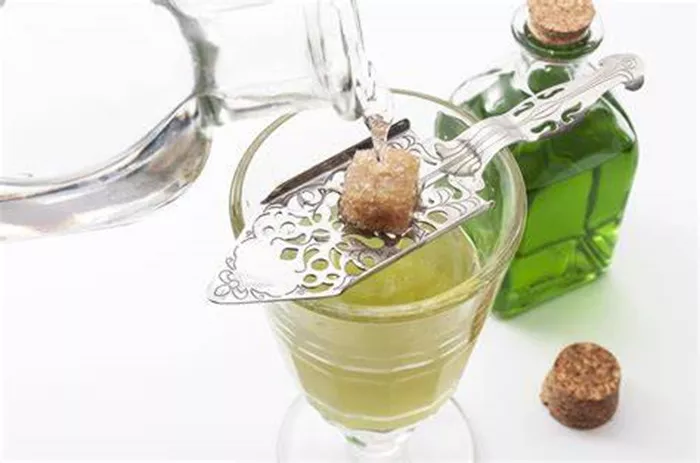Absinthe is a highly alcoholic spirit that is known for its distinct green color and strong flavor. It has a long and storied history, with many myths and legends surrounding its origins and effects. One thing that is clear, however, is that absinthe is made from a complex blend of herbs and botanicals that give it its unique taste and aroma. In this article, we’ll explore what absinthe is made of, including the key ingredients and the process of making absinthe. By the end of this article, you’ll have a better understanding of what goes into this iconic spirit.
Introduction to Absinthe
Origins of Absinthe
Types of Absinthe
Key Ingredients in Absinthe:
1. Wormwood:
Wormwood is the key ingredient in absinthe, and it is what gives the spirit its distinctive flavor and aroma. Wormwood is a bitter herb that is native to Europe, and it has been used for centuries to treat a variety of ailments. In absinthe, wormwood is used in the form of a concentrated extract, which is added to the spirit during the distillation process.
2. Anise:
Anise is another key ingredient in absinthe, and it is what gives the spirit its characteristic licorice flavor. Anise is a flowering plant that is native to the eastern Mediterranean, and it has been used in cooking and medicine for thousands of years. In absinthe, anise is used in the form of an essential oil, which is added to the spirit during the distillation process.
3. Fennel:
Fennel is a third key ingredient in absinthe, and it is what gives the spirit its sweet, slightly spicy flavor. Fennel is a flowering plant that is native to the Mediterranean region, and it has been used in cooking and medicine for thousands of years. In absinthe, fennel is used in the form of an essential oil, which is added to the spirit during the distillation process.
Other Herbs and Botanicals:
In addition to wormwood, anise, and fennel, absinthe may also contain a variety of other herbs and botanicals, depending on the recipe and the distiller. Some common herbs and botanicals used in absinthe include:
Hyssop: a flowering plant that is native to Europe and Asia, and is used for its minty flavor and aroma.
Lemon balm: a fragrant herb that is native to Europe and Asia, and is used for its lemony flavor and aroma.
Angelica root: a root vegetable that is native to Europe and Asia, and is used for its earthy flavor and aroma.
Star anise: a fruit that is native to China, and is used for its sweet, licorice-like flavor and aroma.
The Process of Making Absinthe:
The process of making absinthe is a complex and time-consuming one, involving several stages of distillation and maceration. Here is a brief overview of the process:
1. Maceration:
The first step in making absinthe is to macerate the herbs and botanicals in a high-proof alcohol, such as neutral grain spirit. The herbs and botanicals are typically placed in a large container, and the alcohol is added to cover them completely. The mixture is then left to steep for several hours or days, depending on the recipe and the desired flavor profile.
2. Distillation:
Once the maceration is complete, the mixture is distilled in a copper still. The still is heated, and the vapors are condensed and collected in a separate container. This process is repeated several times, with the distillate being collected each time. The final distillate is typically a clear, high-proof alcohol that is infused with the flavors and aromas of the herbs and botanicals.
3. Coloring:
After the distillation is complete, the absinthe is typically colored using natural ingredients, such as chlorophyll or caramel. This gives the spirit its distinctive green color.
4. Dilution:
Finally, the absinthe is diluted with water to bring it down to its desired alcohol content. This is typically done by adding water to a glass of absinthe, which causes the spirit to louche, or become cloudy. The louche effect is caused by the essential oils in the absinthe becoming suspended in the water.
The History and Controversy Surrounding Absinthe
1. The Belle Époque and the Absinthe Craze
2. The Ban on Absinthe
3. The Resurgence of Absinthe
See Also: What Is in Absinthe? A Comprehensive Guide
The Cultural Significance of Absinthe
1. Absinthe in Art
2. Absinthe in Literature
3. Absinthe in Popular Culture
Conclusion:
In conclusion, absinthe is a complex and fascinating spirit that is made from a blend of herbs and botanicals. Wormwood, anise, and fennel are the key ingredients in absinthe, but it may also contain a variety of other herbs and botanicals. The process of making absinthe is a time-consuming one, involving several stages of distillation and maceration. By understanding what goes into absinthe, you can better appreciate its unique flavor and aroma, and enjoy it responsibly.
You might be interested


